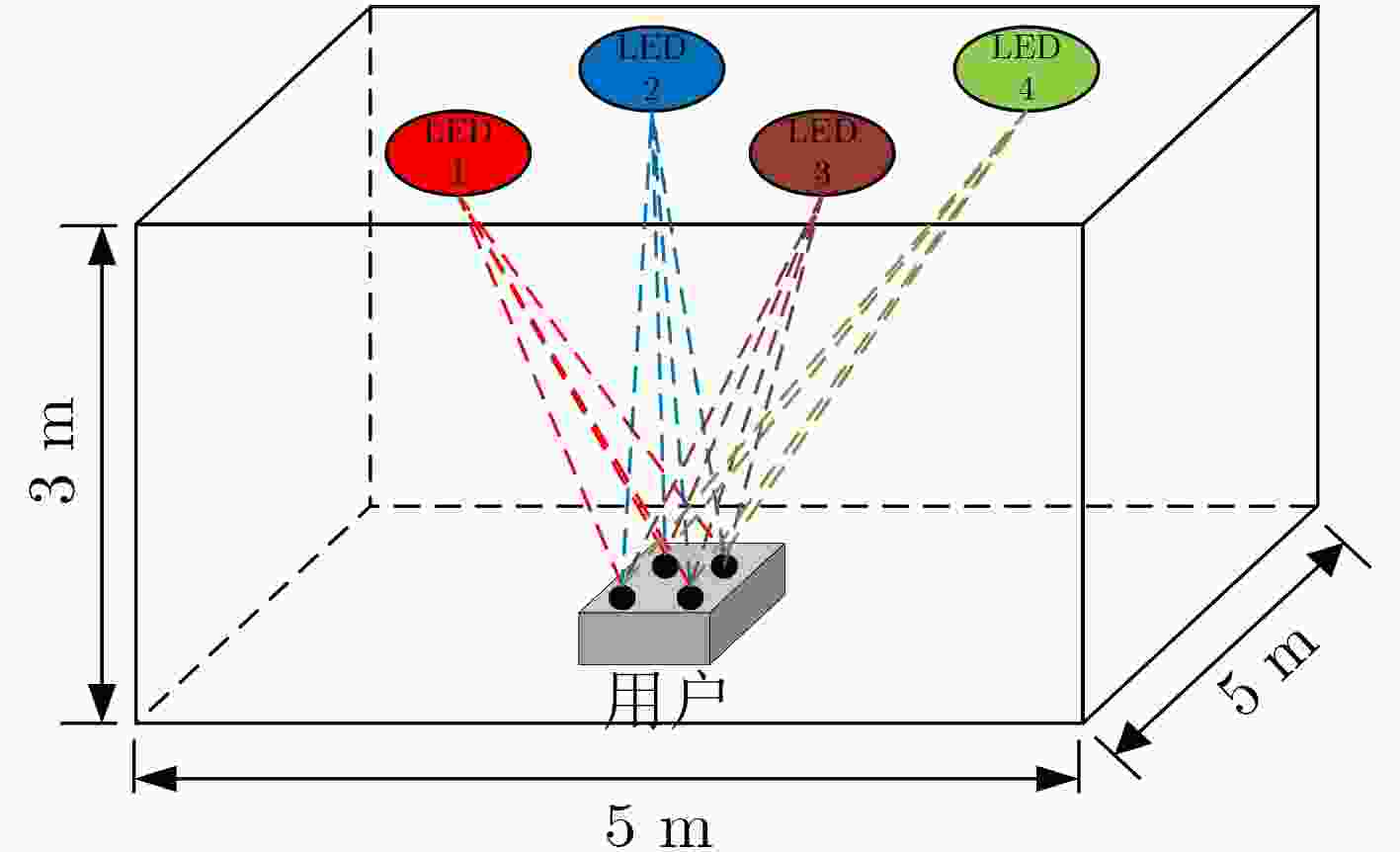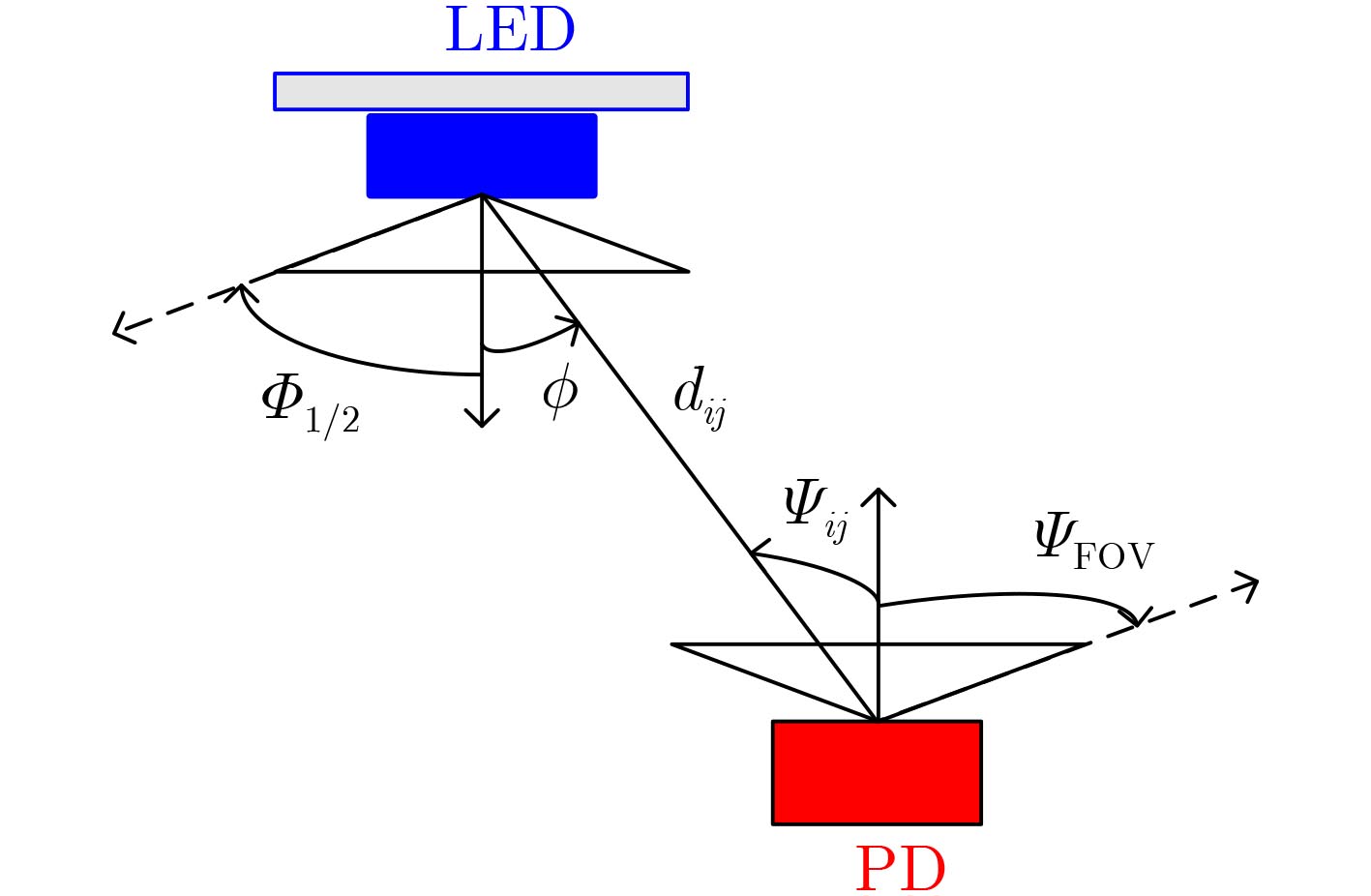SVM-aided Signal Detection in Generalized Space Shift Keying Visible Light Communication System
-
摘要: 针对室内广义空移键控(GSSK)调制的可见光通信(VLC)系统,该文提出一种基于支持向量机(SVM)的机器学习信号检测算法。在一般的VLC系统中,极大似然(ML)检测是最优检测算法,但是ML检测算法具有很高的计算复杂度。为了解决此问题,该文利用机器学习中的SVM分类思想实现对系统接收端的信号检测,以在保证信号检测正确率的情况下,降低计算复杂度,提高GSSK-VLC系统的信号检测效率。仿真结果表明,该文提出的针对室内GSSK-VLC系统的SVM信号检测算法与ML检测算法相比,在具有接近ML的误比特率(BER)性能的同时,计算复杂度明显降低,有效提升了系统的检测性能。Abstract: Novel signal detection technique is conceived for Generalized Space Shift Keying (GSSK) modulated indoor Visible Light Communication (VLC) system, which is aided by one of popular machine learning approach termed as Support Vector Machine (SVM). For general classic VLC system, as the optimal detection algorithm, Maximum Likelihood (ML) detection has a high computational complexity. In order to alleviate this problem, classification idea in SVM is utilized to realize signal detection at the user’s receiving end by a particular trained learning model. As a result, a signal detection algorithm for the considered GSSK-VLC system based on SVM is designed with lower computational complexity and nearly optimal detection accuracy. Simulation results demonstrate that the proposed SVM-aided signal detection technique can have near optima ML Bit Error Rate (BER) performance while the computational complexity is significantly reduced in the considered indoor GSSK-VLC system
-
表 1 GSSK-VLC系统标签
$n$ ${l_n}$ ${i_n}$ LED index 1 1 000 LED 1 & 2 2 2 001 LED 1 & 3 3 3 010 LED 1 & 4 4 4 011 LED 1 & 5 5 5 100 LED 2 & 3 6 6 101 LED 2 & 4 7 7 110 LED 2 & 5 8 8 111 LED 3 & 4 表 2 LED位置的空间分布坐标
4 LEDs 8 LEDs LED $({O_X},{O_Y},{O_Z})\;{ \rm{m} }$ 1 (1.25, 0.35, 3) 1 (1.25, 1.25, 3) 2 (3.85, 0.35, 3) 2 (3.25, 1.25, 3) 3 (1.25, 1.85, 3) 3 (1.35, 3.25, 3) 4 (3.85, 1.85, 3) 4 (3.25, 3.25, 3) 5 (1.25, 3.25, 3) 6 (3.85, 3.25, 3) 7 (1.25, 4.25, 3) 8 (3.85, 4.25, 3) 表 3 系统仿真参数设置
发射端 (LED) 接收端(PD) LED数量$({N_{\rm{t} } })$ 4, 8 PD数量$({N_r})$ 4 距地面高度 3 m 距地面高度 0.85 m 半功率半角$({\phi _{1/2} })$ ${60^ \circ }$ PD的物理面积$({A_{\rm{PD} }})$ $1 \;{{\rm{cm}} ^2}$ 光学滤波器增益$({{T}_s}(\psi ))$ 1.0 PD的FoV半角$({\varPsi _{\rm{FoV}}})$ ${60^ \circ }$ 光电转换效率$(\eta )$ 813.6 μW/mA 折光率$(\beta )$ $1.5$ 调制指数$(\alpha )$ $0.1$ PD响应度$(R)$ 100 μA/mW 表 4 针对GSSK-VLC系统基于不同检测算法所需时间对比
检测算法 计算时间(s) KMC 175.8836 KMC (20) 3517.6607 KMC (50) 8794.1735 IKMC 879.418 SVM 98.6687 ML 10904.7794 -
[1] LIU Wenlong, ZHANG Ying, and JIN Minglu. Lagrangian detection for generalized space-shift keying MIMO systems[J]. IEEE Transactions on Vehicular Technology, 2017, 66(9): 8585–8589. doi: 10.1109/TVT.2017.2678528 [2] ZHANG Xinhe, LIU Qian, and JIN Minglu. Detection of generalized space shift keying signal with sparse reconstruction[J]. IEEE Transactions on Vehicular Technology, 2017, 66(6): 5471–5475. doi: 10.1109/TVT.2016.2621160 [3] JEGANATHAN J, GHRAYEB A, and SZCZECINSKI L. Generalized space shift keying modulation for MIMO channels[C]. 2008 IEEE 19th International Symposium on Personal, Indoor and Mobile Radio Communications, Cannes, France, 2008: 1–5. doi: 10.1109/PIMRC.2008.4699782. [4] 吴楠, 王旭东, 姚凯莉, 等. 可见光通信中的无载波位相调制技术[J]. 电子与信息学报, 2017, 39(2): 360–366. doi: 10.11999/JEIT160343WU Nan, WANG Xudong, YAO Kaili, et al. Carrier-less position/phase modulation for visible light communications[J]. Journal of Electronics &Information Technology, 2017, 39(2): 360–366. doi: 10.11999/JEIT160343 [5] FATH T and HAAS H. Performance comparison of MIMO techniques for optical wireless communications in indoor environments[J]. IEEE Transactions on Communications, 2013, 61(2): 733–742. doi: 10.1109/TCOMM.2012.120512.110578 [6] WANG T Q, SEKERCIOGLU Y A, and ARMSTRONG J. Analysis of an optical wireless receiver using a hemispherical lens with application in MIMO visible light communications[J]. Journal of Lightwave Technology, 2013, 31(11): 1744–1754. doi: 10.1109/JLT.2013.2257685 [7] YING Kai, QIAN Hua, BAXLEY R J, et al. Joint optimization of precoder and equalizer in MIMO VLC systems[J]. IEEE Journal on Selected Areas in Communications, 2015, 33(9): 1949–1958. doi: 10.1109/JSAC.2015.2432515 [8] MITCHELL T, BUCHANAN B, DEJONG G, et al. Machine learning[J]. Kluwer International, 2003, 4(1): 417–433. doi: 10.1007/978-1-4613-2279-5 [9] 佟鑫, 李莹, 陈岚. SVM算法在硬件木马旁路分析检测中的应用[J]. 电子与信息学报, 2020, 42(7): 1643–1651. doi: 10.11999/JEIT190532TONG Xin, LI Ying, and CHEN Lan. Application of SVM machine learning to hardware trojan detection using side-channel analysis[J]. Journal of Electronics &Information Technology, 2020, 42(7): 1643–1651. doi: 10.11999/JEIT190532 [10] LIANG Hanwen, CHUMG W H, and KUO S Y. Coding-aided K-means clustering blind transceiver for space shift keying MIMO systems[J]. IEEE Transactions on Wireless Communications, 2016, 15(1): 103–115. doi: 10.1109/TWC.2015.2467394 [11] YOU Longfei, YANG Ping, XIAO Yue, et al. Blind detection for spatial modulation systems based on clustering[J]. IEEE Communications Letters, 2017, 21(11): 2392–2395. doi: 10.1109/LCOMM.2017.2734648 [12] ZHANG Lijuan and JIN Minglu. A constrained clustering-based blind detector for spatial modulation[J]. IEEE Communications Letters, 2019, 23(7): 1170–1173. doi: 10.1109/LCOMM.2019.2915304 [13] JIANG Rui, SUN Caiming, ZHANG Long, et al. Deep learning aided signal detection for SPAD-based underwater optical wireless communications[J]. IEEE Access, 2020, 8: 20363–20374. doi: 10.1109/ACCESS.2020.2967461 [14] LEE H, LEE I, and LEE S H. Deep learning based transceiver design for multi-colored VLC systems[J]. Optics Express, 2018, 26(5): 6222–6238. doi: 10.1364/OE.26.006222 [15] YUAN Youli, ZHANG Min, LUO Pengfei, et al. SVM-based detection in visible light communications[J]. Optik, 2017, 151: 55–64. doi: 10.1016/j.ijleo.2017.08.089 [16] MOSTAFA A and LAMPE L. Physical-Layer security for MISO visible light communication channels[J]. IEEE Journal on Selected Areas in Communications, 2015, 33(9): 1806–1818. doi: 10.1109/JSAC.2015.2432513 [17] MOSTAFA A and LAMPE L. Optimal and robust beamforming for secure transmission in MISO visible-light communication links[J]. IEEE Transactions on Signal Processing, 2016, 64(24): 6501–6516. doi: 10.1109/TSP.2016.2603964 [18] WANG Fasong, LIU Chaowen, WANG Qi, et al. Secrecy analysis of generalized space-shift keying aided visible light communication[J]. IEEE Access, 2018, 6: 18310–18324. doi: 10.1109/ACCESS.2018.2799658 [19] HANDTE T, MULLER A, and SPEIDEL J. BER analysis and optimization of generalized spatial modulation in correlated fading channels[C]. The 70th IEEE Vehicular Technology Conference Fall (VTC 2009-Fall), Anchorage, USA, 2009: 1–5. doi: 10.1109/VETECF.2009.5378677. -






 下载:
下载:






 下载:
下载:
